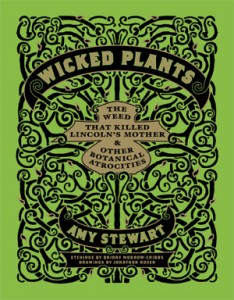This past August, Mom G. and I attended Garden Day at Michigan State University. There were some interesting looking seminars and more importantly Amy Stewart was scheduled as the keynote speaker. I had first read articles written by Amy on Garden Rant, and later was gifted her book Wicked Plants by my friend Mrs. R. Needless to say, I was super excited to hear her speak.
 Wicked Plants is a pretty fantastic book. It has beautiful illustrations, interesting plants, and a creepy vibe… all things I adore. In her first talk, Amy commented on the overall theme of the book and touched on a few plants featured therein. She said when creating the book, she wasn’t interested in a field guide of poisonous plants. She wanted stories with victims and villains on which to pin the crime. Some of the plants come from far away (relative to USDA Zone 6a) places, but others are sold at local nurseries here. Still other plants from the book live right here on the Lot.
Wicked Plants is a pretty fantastic book. It has beautiful illustrations, interesting plants, and a creepy vibe… all things I adore. In her first talk, Amy commented on the overall theme of the book and touched on a few plants featured therein. She said when creating the book, she wasn’t interested in a field guide of poisonous plants. She wanted stories with victims and villains on which to pin the crime. Some of the plants come from far away (relative to USDA Zone 6a) places, but others are sold at local nurseries here. Still other plants from the book live right here on the Lot.
“All Natural” Does Not Mean “Safe”
One thing Amy said that made me think “huh, funny I had never thought of it that way,” is people often confuse the term natural for something that is inherently safe or considered “good for us.” I’ve seen a lot of homemade cleaners and toiletries made from natural ingredients populating Pinterest boards. Granted I haven’t made the effort to recreate these, but I also never stopped to wonder if the ingredients, albeit natural, are really safe to use. Plants do not have the ability to run away from threats. Since flight is not an option, they have evolved to utilize fight in the form of toxic seeds, blistering sap, and many other techniques.
Beware the Backyard
In Wicked Plants I enjoyed learning more about plants we have grown or are growing here on the Lot. I knew about a few of them, yet others are so commonly used in the decorative landscapes I was surprised to find them in the book.
Sweet Woodruff (Galium odoratum)
I knew this ground cover was used in a German, alcoholic drink of some kind. Now I know the leaves of sweet woodruff are used in the making of May Wine. Here in the U.S., the plant is only considered food safe as a flavoring in alcoholic drinks. High doses can result in dizziness, paralysis, coma, or death.
Foxglove (Digitalis spp.)
I knew this pretty plant was poisonous so I moved it outside of the backyard to keep it away from the Four-footed Management. Also, in the album Hazards of Love, the Rake rids himself of a pesky child by feeding her foxglove. All parts of plant if ingested can cause ailments including an upset stomach, headache, and even fatal heart problems. Skin irritation can be caused just by handling the plant.
Lenten Rose (Hellebore spp.)
Sap from the lenten rose can cause irritation to the skin while ingestion can result in vomiting, dizziness, and convulsions. I had no idea this plant was in any way toxic. Some historians link this plant to the First Sacred War and the victory of the Greek military alliance over the city of Kirrha.
Tulip (Tulipa spp.)
Beyond producing an irritating sap, the tulip can cause painful swelling, rashes, and cracks in the skin to some people when being handled. Ingestion of the bulbs can cause vomiting, breathing problems, and severe weakness. I wonder if the squirrels on the Lot who dig up, take a bite of, and discard the tulip bulbs every experience this.
Yew (Taxus baccata)
When the arborvitaes were removed from the south side of the house, I spared the sole yew in the bed. It looks kind of funny by itself now, but I couldn’t bring myself to have it pulled out since it was not interfering with anything. Little did I know this plant’s poisonous nature was used in Caesar’s Gallic Wars as a type of suicide dose to avoid defeat. Every part of the plant except the flesh of the berry (the seed is toxic) is poisonous.
The Most Wicked Plant of All
Throughout her research for Wicked Plants, Amy said she found no other plant as deadly as Nicotiana tabacum, also know as the cultivated tobacco plant. It contains nicotine in its leaves which wards off insects. Tobacco covers 9.8 million acres of land, has killed ninety million people, and continues to kill about 5 million more a year.
The Fear of Foliage
So naturally toward the end of her talk, Amy made the point we as gardeners do not have to be afraid of everything we grow. Instead, we should have an awareness and respect for plants. Used correctly, some deadly plants are valuable ingredients in medications. Children should be taught not to put flowers and berries, any part of a plant they find growing outside, into their mouths. Pet owners should make an attempt to keep poisonous plants out of areas where a bored pet may take a nibble. And gardeners, remember to wear those gloves!